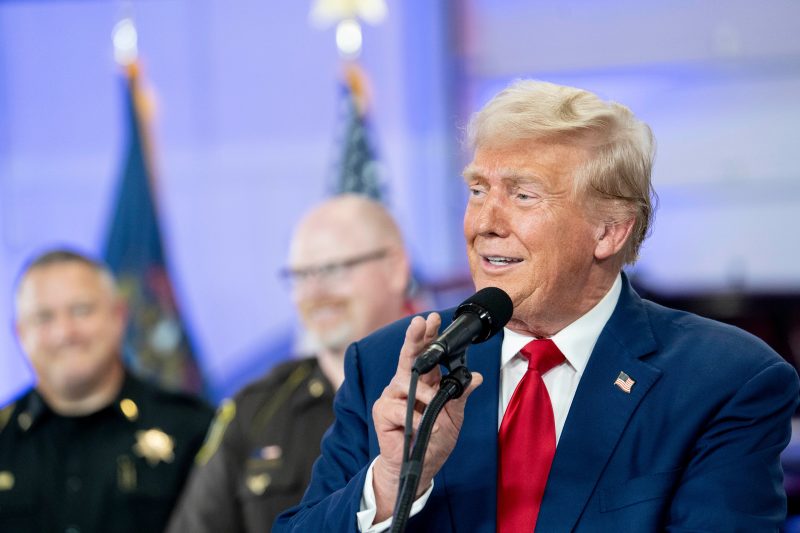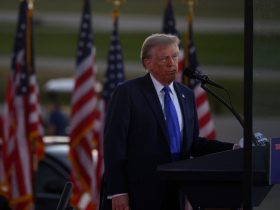On Tuesday, as former president Donald Trump was making remarks at a Michigan sheriff’s office, residents of New York City were once again faced with a difficult choice. Was it worth walking across the street to buy bread at the bodega, given the likelihood that doing so would mean being shot or mugged?
At least, that’s how Trump suggested they would approach their daily lives. The focus of his event was violent crime, something that he insists has surged since he left office — both in American cities and, apparently, in the White House itself.
‘The crime is so out of control in our country,’ Trump said. ‘I mean, you have cities — I will say this, the top 25, almost all are run by Democrats, and they have very similar policies. It’s just insane.’
(It is true that most large cities are run by Democrats, but that is because most residents of cities are Democrats.)
“But you can’t walk across the street to get a loaf of bread,” Trump continued. “You get shot. You get mugged. You get raped, you get whatever it may be. And you’ve seen it and I’ve seen it, and it’s time for a change. We have to bring back our cities. We have these cities that are great cities where people are afraid to live in them, and they’re fleeing the cities of our country.”
There’s a lot that could be unpacked there, but let’s just take the Gordian knot approach: It’s all just fear-mongering. We can say that not only because baseless fear-mongering is a centerpiece of Donald Trump’s political rhetoric but because it’s obviously false. Sure, Fox News airs individual crimes on repeat, the stuff that “you’ve seen and I’ve seen,” at least if we watch Fox. But we might have seen far more people walk outside without being shot. We might have noticed that American cities still have residents.
Since Harris became vice president, Trump said, ‘her administration’s crime statistics show she’s presided over a 43 percent increase in violent crime. These are all government numbers, 43 percent increase in violent crime.’
Trump’s referring to data from the Bureau of Justice Statistics indicating a 43 percent increase in reported crime victimization from 2020 to 2022. You’ll notice the end point there is two years ago. That’s because crime data is consistently both incomplete and delayed, making it easy for assessments of the current state of crime to rely on anecdotes like Trump’s.
But that is also an indirect measure of crime, looking at self-reported incidents of violence. Harris’s administration — also known as the Biden administration — also collects data through the FBI that shows a clear decline in violent crime since Trump left office. Other recent year-over-year data shows a big drop in homicides in American cities, presumably not one Trump is willing to credit to their Democratic mayors.
Data from the Michigan State Police, compiled by the Detroit News as Trump was preparing to visit the state, shows a similar drop in violent crime. Trump was arguing that violent crime was up in a state where violent crime is clearly down.
‘The Trump campaign had initially agreed that Trump would participate in an interview with The Detroit News on Tuesday,’ the paper’s Craig Mauger reported. ‘But after the newspaper began asking about the Michigan crime data before the event, a campaign aide said the presidential candidate no longer had time for an interview after the speech.’
All of this is well-worn territory by now. Trump and his allies keep trying to hype crime as an issue, leveraging the persistent and long-standing gap between how people perceive crime (always going up) and what is happening with violent crime (down substantially since the 1990s, though with a spike beginning during Trump’s last year in office).
But Trump explored some new territory, too, that showed how he deploys the concept of violence haphazardly in order to exaggerate how dangerous or dire a situation might be.
It came when he was again misrepresenting President Joe Biden’s decision to withdraw from the presidential race.
‘That was a coup. And I’m no fan of his at all,’ Trump said. ‘And it started with the debate, and from that point on, it just got worse and worse. But that was a coup. It was a vicious, violent overthrow of a president of the United States.’
Again, we can Gordian-knot this: This is patently ridiculous. It wasn’t a coup, it wasn’t an overthrow and, most of all, it wasn’t violent. Trump’s again trying to minimize his role in the Capitol riot by suggesting that the transition from Biden to Harris is somehow an equivalent threat to presidential power. But in Michigan he took that tacit comparison further.
The lesson here is that Trump will claim to witness violence in any context where he thinks it punches up his sales pitch. But we can also work the other direction: if he thinks Biden deciding not to seek reelection constitutes something ‘violent,’ maybe he thinks that someone having to wait at a crosswalk before buying their bread is the same as their being shot.
Maybe violent crime is up in America because Trump thinks anything that keeps him out of power is an act of violence. In which case, since 2020, it is.










